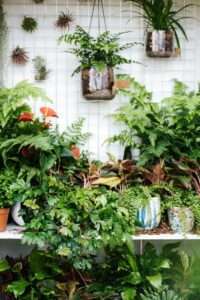 Houseplant books and hang tags often mention that indoor plants appreciate humidity. The typical home doesn’t always offer moist air, though, especially in winter, when the air is naturally more dry and most heating systems dry it even further.
Houseplant books and hang tags often mention that indoor plants appreciate humidity. The typical home doesn’t always offer moist air, though, especially in winter, when the air is naturally more dry and most heating systems dry it even further.
Clustering plants together creates a microclimate with increased humidity.
Some recommend misting the air around houseplants with a spray bottle as a way to increase humidity. The effect doesn’t last very long after you stop misting. Here are easier, more effective ways to increase humidity around your houseplants:
Fill the saucer underneath the pot with pea gravel or aquarium gravel. There are also drip trays designed for this purpose; a large drip tray can accommodate several separate pots (see next tip). Add water to the saucer so that the gravel is damp. Place the pot on top of the gravel. The water will slowly evaporate, adding moisture to the air immediately around the plant. The gravel is necessary because it elevates the pot, preventing the soil from wicking up the moisture and defeating the purpose (besides creating soil conditions that are potentially too damp for the plant). As the water evaporates you’ll need to top it off, so check its level each time you water the plant.
Make a humid microclimate by clustering groups of houseplants together. They can be in individual pots, or you can create large dish gardens of several plants (just make sure they appreciate the same soil conditions and have a similar rate of growth). Clustering the plants will increase humidity thanks to their transpiration and the moisture released by their soil surfaces and gravel-lined drip tray.
Use glass cloches or large glass jars to increase humidity around single plants. Simply place the cloche or jar upside down over the plant and its pot. This serves as a mini greenhouse, trapping moisture inside. Be sure to take the cloche or jar off a couple of times a week to let fresh air in.
Place potted plants inside an empty fishtank, with or without a lid. Again, the sides of the tank will trap moisture that’s released from the plants leaves and soil. (If you’re more ambitious, you can of course take the extra step of planting the fishtank as a terrarium.)
Keep your houseplants in a room that’s naturally more humid than others, such as the bathroom or kitchen. The plants will appreciate the steam from the shower, tub, dishwasher, kitchen sink, tea kettle, pasta water and so on. If you run a humidifier in any room for health reasons, that would of course be a good placement for humidity-loving plants, too. Just make sure that the room you choose also provides adequate light.
For more advice on identifying, understanding and meeting the needs of your houseplants, I recommend the book The New Plant Parent by David Cheng. Cheng takes a methodical approach to getting to know his plants and caring for them, and he offers unique and insightful advice in his book. For inspiration in grouping plants together, which not only increases humidity but also makes for a compelling display, look at Urban Jungle by Igor Josifociv and Judith de Graaf; or Indoor Jungle by Lauren Camilleri and Sophia Kaplan. Both books offer care advice as well as photographs of houseplant collections and interviews with the people who tend them.
MEGHAN SHINN www.hortmag.com




